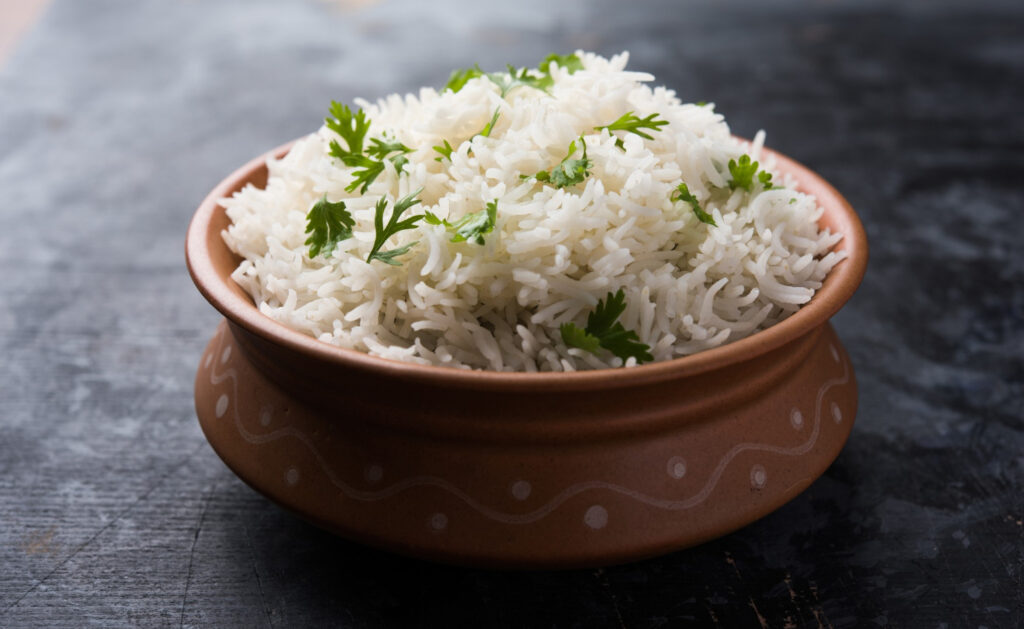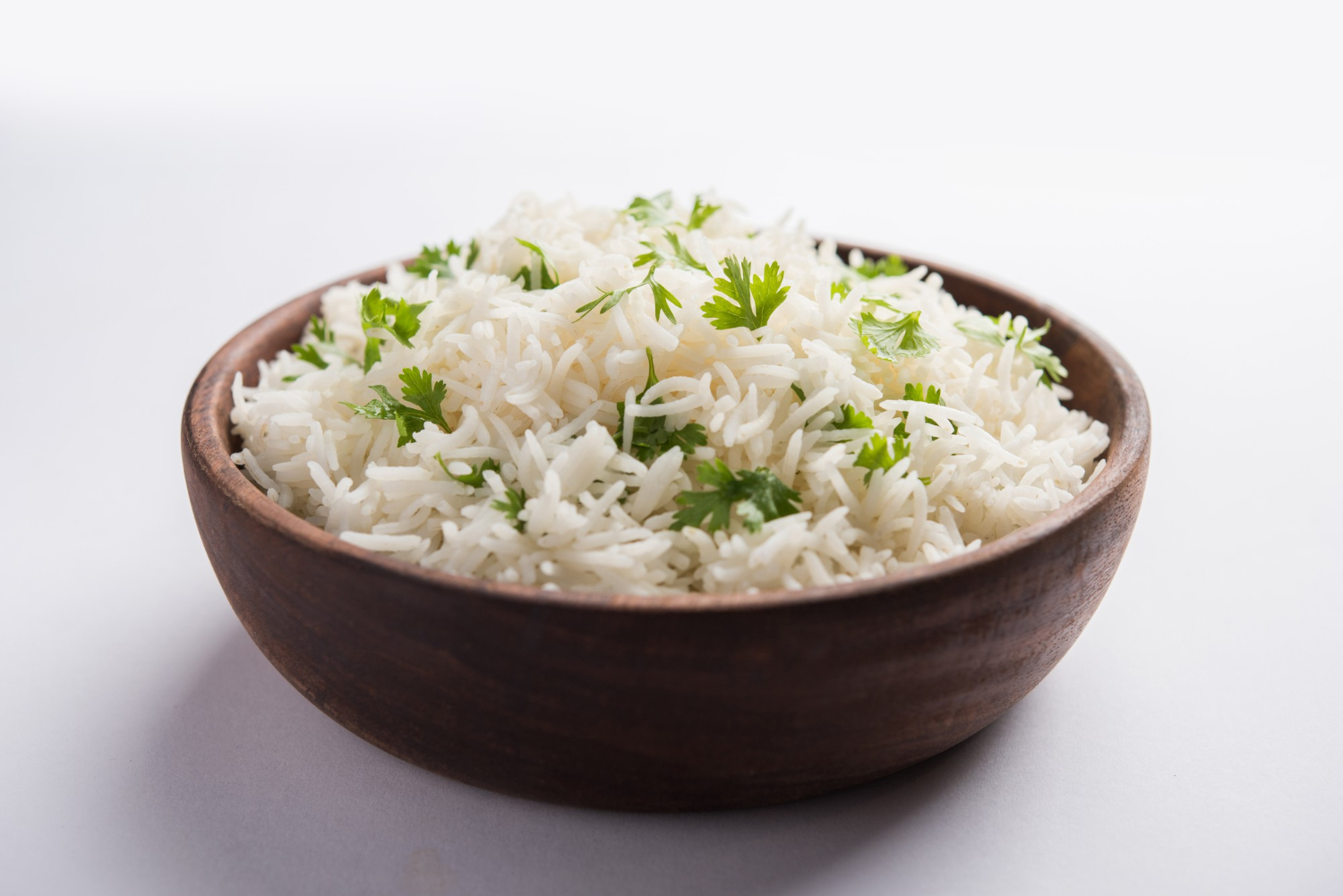This post may contain affiliate links. Please read our disclosure policy.
In India, plain rice is more than just food; it’s a part of our culture. According to recent statistics, India is the second-largest producer and consumer of rice globally, with an average annual consumption of over 100 kilograms per capita.
While each region has its own way of enjoying rice, it’s always a staple in our meals. For example, in the North, people might eat more roti or bread, but in the South and the East, rice is the star of the show. Then there are places like the central regions where both rice and roti are loved equally. So no matter where you go in India, rice holds a special place on our plates and in our hearts, connecting us to our rich culinary heritage.

The most popular type of rice found in Indian cuisine, both in India and internationally, is Long Grain Basmati Rice. Additionally, there are other varieties such as Sona Masoori, Indrayani, Kolam, and more that are also commonly used.
There are various methods and kitchen appliances available for cooking rice. In this guide, we’ll cover four popular methods: stove top, pressure cooker, Instant Pot, and rice cooker.
Today, I’m sharing a recipe for restaurant-style rice that pairs perfectly with dishes like butter chicken or other curries. It’s super simple and quick to make, taking just a few minutes from start to finish.
Ingredients
long-grain white rice, water, , whipping cream, salt (optional), ghee (optional)
Recipe Instructions

- Rinse the rice: Place the rice in a bowl and rinse it multiple times under cold water until the water runs clear. This helps remove excess starch and prevents the rice from becoming too sticky.
Stove top:
- Cook the rice: In a medium-sized saucepan, combine the rinsed rice, water, cream(optional) and a pinch of salt. Bring the water to a boil over medium-high heat.
- Simmer: Once the water reaches a rolling boil, reduce the heat to low and cover the saucepan with a tight-fitting lid. Allow the rice to simmer gently for 18-20 minutes, or until all the water is absorbed and the rice is tender.
Pressure cooker:
- Add Rice and Water: Transfer the rinsed rice to the pressure cooker. Add 2 cups of water and a pinch of salt, if desired.
- Pressure Cook: Close the pressure cooker with its lid securely. Place it on the stove top and cook for 3-4 whistles.
- Natural Release: Once the cooking time is complete, switch off the gas and allow the pressure to release naturally. This usually takes about 5-10 minutes. Open the lid carefully after the pressure is released.
Instant Pot
- Add Rice and Water: Transfer the rinsed rice to the Instant Pot insert. Add 1 1/4 cups of water and a pinch of salt, if desired.
- Pressure Cook: Close the Instant Pot with its lid and set the steam release valve to the sealing position. Select the “Pressure Cook” or “Manual” setting and set the cooking time to 4 minutes at high pressure.
- Cook: Once you’ve set the cooking time, the Instant Pot will start building pressure, and the cooking cycle will begin. After the cooking time is complete, allow the pressure to naturally release for about 10 minutes.
- Quick Release: After the natural release, carefully switch the steam release valve to the venting position to release any remaining pressure quickly.
- Once the pressure has fully released and the float valve drops, it’s safe to open the lid.
Rice cooker
- Add Rice and Water: Transfer the rinsed rice to the inner pot of the rice cooker. Add 2 cups of water and a pinch of salt, if desired.
- Start Cooking: Close the lid of the rice cooker and select the “Cook” or “White Rice” setting, depending on your rice cooker model. The rice cooker will automatically begin cooking the rice.
- Wait for Completion: Allow the rice cooker to complete the cooking cycle, which usually takes about 8-10 minutes, depending on the type of rice cooker and the amount of rice being cooked.
Serving:
- While using any of the above methods, once the plain rice is cooked, remove from the heat and let it sit for a few minutes for the rice grains to take shape. Add 1 teaspoon ghee to make rice fragrant.
- Then, use a fork to fluff the rice gently, loosening the grains. Serve hot as a side dish or as a base for your favorite recipes.
Serving Suggestions
- Serve alongside meat and veggie curries like butter chicken, dals, stir-fries, or grilled meats for a satisfying meal.
- Mix cooked rice with sautéed vegetables, tofu, or chicken for a quick and nutritious fried rice dish.
- Enjoy leftover rice as a breakfast option by reheating it with a splash of milk and your favorite toppings for a comforting rice pudding.


Tips and Tricks
- For fluffier rice, let it sit, covered, for a few minutes after cooking before fluffing it with a fork.
- Experiment with different types of rice, such as basmati, jasmine, or brown rice, for varied flavors and textures.
- To add extra flavor to plain rice, cook it in broth instead of water or add a knob of butter or a splash of coconut milk while simmering.
- Add a cinnamon stick, cardamom pods, or cloves to the cooking water for aromatic rice.
- Resist the temptation to stir the rice while it’s cooking, as this can make it sticky. Just let it simmer gently, covered, until all the water is absorbed.
Meal Prep tips
- Once you’ve cooked rice, it can stay fresh in the fridge for about 6-7 days. You can even portion it out with your favorite curry or side into separate containers. When you’re ready to eat, just take it out of the fridge and reheat it whenever you want.
- If you prefer freshly cooked rice straight from the pot, you can also wash and soak the rice, then store it in an airtight container in the fridge for up to 4-5 days. When you’re ready to cook, just take it out and follow the instructions.
FAQs
Q: Can I make plain rice in a rice cooker?
A: Yes, you can easily make plain rice in a rice cooker by following the manufacturer’s instructions for rice to water ratios.
Q: Is rinsing rice necessary?
A: Rinsing rice helps remove excess starch, which can cause it to become gummy. While it’s not strictly necessary, rinsing can improve the texture of the cooked rice, especially for dishes like pilafs or fried rice where distinct grains are desired.
Q: How can I tell if the rice is cooked?
A: When the rice is done, all the water should be absorbed, and the grains should be tender but still slightly firm. If there’s excess water, continue cooking uncovered until it evaporates.
Q: How do I store leftover rice?
A: Allow leftover rice to cool completely before transferring it to an airtight container and storing it in the refrigerator for up to 3-4 days. Reheat it gently in the microwave or on the stovetop with a splash of water to prevent it from drying out.

Plain Rice
Ingredients
- 1 cup long-grain white rice
- 2 cups water
- 1 pinch salt optional
- 1 tablespoon whipping cream
- 1 teaspoon ghee optional
Instructions
- Place the rice in a bowl and rinse it multiple times under cold water until the water runs clear. This helps remove excess starch and prevents the rice from becoming too sticky.
For Stove Top:
- In a medium-sized saucepan, combine the rinsed rice, water, cream(optional) and a pinch of salt. Bring the water to a boil over medium-high heat.
- Once the water reaches a rolling boil, reduce the heat to low and cover the saucepan with a tight-fitting lid. Allow the rice to simmer gently for 18-20 minutes, or until all the water is absorbed and the rice is tender.
In the Pressure Cooker:
- Transfer the rinsed rice to the pressure cooker. Add water, cream(optional) and a pinch of salt, if desired.
- Close the pressure cooker with its lid securely. Place it on the stove top and cook for 3-4 whistles.
- Once the cooking time is complete, switch off the gas and allow the pressure to release naturally. This usually takes about 5-10 minutes. Open the lid carefully after the pressure is released.
In the Instant Pot:
- Transfer the rinsed rice to the Instant Pot insert. Add water, cream(optional) and a pinch of salt, if desired.
- Close the Instant Pot with its lid and set the steam release valve to the sealing position. Select the "Pressure Cook" or "Rice" setting and set the cooking time to 10 minutes on high pressure.
- Once the rice is cooked, allow the pressure to naturally release for about 10 minutes.
- After the natural release, carefully switch the steam release valve to the venting position to release any remaining pressure quickly. Once the pressure has fully released and the float valve drops, it's safe to open the lid.
For Rice Cooker:
- Transfer the rinsed rice to the inner pot of the rice cooker. Add water, cream(optional) and a pinch of salt, if desired.
- Close the lid of the rice cooker and select the "Cook" or "White Rice" setting, depending on your rice cooker model. The rice cooker will automatically begin cooking the rice.
- Allow the rice cooker to complete the cooking cycle, which usually takes about 8-10 minutes, depending on the type of rice cooker and the amount of rice being cooked.
For Serving
- Once the rice is cooked, remove from the heat and let it sit for the rice grains to hold shape. Add 1 teaspoon of ghee to make rice fragrant.
- Then, use a fork to fluff the rice gently, loosening the grains. Serve hot as a side dish or as a base for your favorite recipes.
Notes
-
- Serve alongside meat and veggie curries, dals, stir-fries, or grilled meats for a satisfying meal.
- Mix cooked rice with sautéed vegetables, tofu, or chicken for a quick and nutritious fried rice dish.
- Enjoy leftover rice as a breakfast option by reheating it with a splash of milk and your favorite toppings for a comforting rice pudding.
- For fluffier rice, let it sit, covered, for a few minutes after cooking before fluffing it with a fork.
- Experiment with different types of rice, such as basmati, jasmine, or brown rice, for varied flavors and textures.
- To add extra flavor to plain rice, cook it in broth instead of water or add a knob of butter or a splash of coconut milk while simmering.
- Add a cinnamon stick, cardamom pods, or cloves to the cooking water for aromatic rice.
- Resist the temptation to stir the rice while it’s cooking, as this can make it sticky. Just let it simmer gently, covered, until all the water is absorbed.
Did you make this recipe?
Please let me know how it turned out for you! Leave a comment below and tag @amusingcooker on Instagram and hashtag it #amusingcooker.

